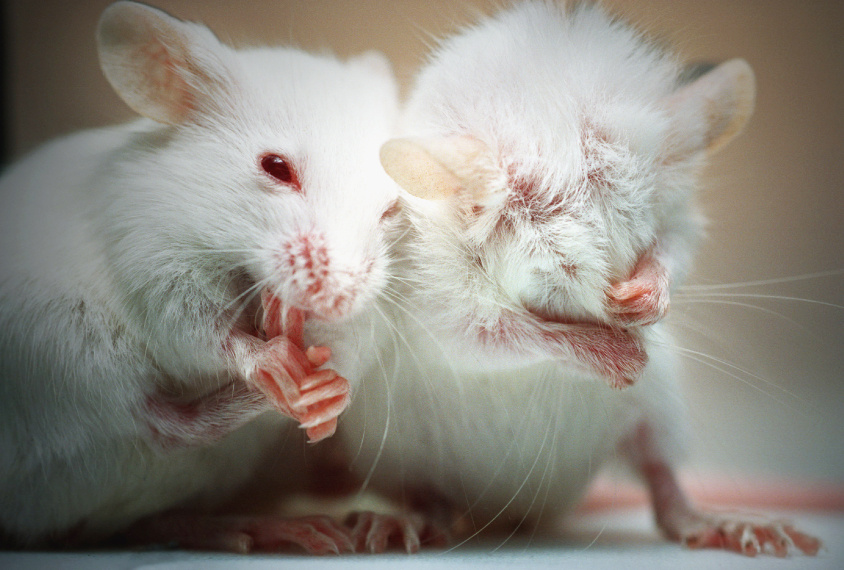
Heidi and Hans-Juergen Koch / Minden Pictures
THIS ARTICLE IS MORE THAN FIVE YEARS OLD
This article is more than five years old. Autism research — and science in general — is constantly evolving, so older articles may contain information or theories that have been reevaluated since their original publication date.
Mice with a genetic glitch in just one copy of SHANK3 show some brain and behavioral features of autism, such as impaired signaling, social problems and repetitive behaviors.
The mice are part of a growing arsenal of laboratory rodents with mutations in SHANK3, a gene with strong ties to autism. But they are the first strain with only one mutant copy of SHANK3 to show a range of autism-like traits1. People with autism who have mutations in this gene similarly carry them in only one copy.
Researchers tend to study animals with mutations in both copies of a gene because the effects are more noticeable, says lead investigator Craig Powell, associate professor of neurology and neurotherapeutics at the University of Texas Southwestern in Dallas.
“But it may be more important that we have mice that have the genetic and biochemical changes that model the human [situation],” Powell says. His team described the new mice 5 August in Autism Research.
Powell and his colleagues put the mice through a vast array of social, motor and behavioral tests. They also compared the mice with another strain that carries the same mutation in both copies of SHANK3.
“This type of rigorous behavioral examination is highly warranted for novel models of autism — a disorder defined solely by behavioral characteristics — but, sadly, has been rarely implemented,” says Jill Silverman, assistant professor of psychiatry and behavioral sciences at the University of California, Davis, who was not involved in the study.
Mouse medley:
The SHANK3 gene encodes multiple forms of the corresponding protein. Some of these forms play structural roles at synapses, the junctions between neurons. The first SHANK3 mouse model, reported in 2010, carries a glitch near the start site of one copy of the gene. These mice have low levels of the longest form of the protein. They also have faulty synapses, but only mild social difficulties.
A second strain of mice, reported in 2011, has a mutation in the middle of both copies of the gene. These mice lack the two longest forms of the protein, and they show social deficits and abnormal synapses. They also groom themselves until they develop severe skin lesions — a feature reminiscent of the repetitive behaviors seen in people with autism.
The new mice carry a slightly bigger mutation in the same region of the gene, but in just one copy. They have low levels of the two longest forms of the protein. But they still show abnormal synapses, social problems and repetitive behaviors.
At 5 to 9 weeks of age, the mice spend more time grooming themselves than controls do. However, they do not groom themselves to the point of creating wounds. Socially, the mice do not show the typical preference for interacting with another mouse rather than an object. They also have trouble recognizing mice they have previously met.
Signal problems:
Powell and his colleagues also made mice with the mutation in both copies of SHANK3, similar to the 2011 mice. These mice show some of the same social problems as those with one mutant copy.
They also show impairments that don’t show up in the other mouse models. They readily fall off of a rotating beam, suggesting unusual clumsiness. And they have trouble learning to locate a hidden platform in a water tank, hinting at spatial learning problems. The discrepancies could result from differences in the genetic background of the mice, or in how they were bred and housed, the researchers say.
Silverman has tested other strains of mice and rats with SHANK3 mutations. She says she, too, has seen that rodents with two mutant copies have more profound behavioral abnormalities than those with only one.
Both new mouse strains have defects in neuronal signaling that are also present in other SHANK3 mutants. These include impairments in long-term potentiation — the process by which synapses become ‘stronger’ with experience — in the hippocampus, a learning and memory center. In the striatum, a region involved in motivation and movement, the mice have altered signaling through receptors for molecules that excite brain activity.
Powell’s team plans to test whether restoring normal SHANK3 during development normalizes behaviors in the mice.
By joining the discussion, you agree to our privacy policy.